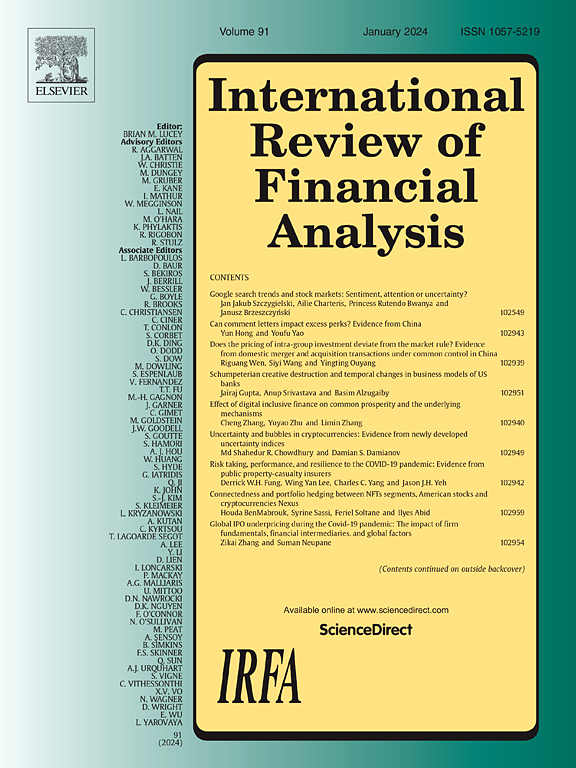Tail risk contagion and connectedness between clean cryptocurrency, green assets and commodity markets
IF 9.8
1区 经济学
Q1 BUSINESS, FINANCE
引用次数: 0
Abstract
This study investigates tail contagion risks among seven clean cryptocurrencies (Cardano, EOS, NANO, TRON, Stellar, Tezos, and Ripple), green assets (the Green Bond Index, Global Clean Energy Index, and ESG Leader Index), and strategic commodities (Gold and WTI). To achieve this objective, the Conditional Autoregressive Value at Risk (CAViaR) model (Engle & Manganelli, 2004) and quantile connectedness framework (Ando et al., 2022) are employed. The analysis covers the period from November 9, 2017, to July 31, 2024, encompassing significant financial crises. The findings indicate that green cryptocurrencies are linked to higher tail risks, particularly during market disruptions, whereas green bonds, ESG indices, and gold show greater resilience. Market interconnectedness is notably stronger during extreme conditions, with spillovers more pronounced in the bullish phases. EOS acts as a net receiver, offering diversification, whereas TRX is a net transmitter of systemic risk. XRP and gold shifted their roles, becoming net receivers during crises. During the pandemic, green bonds and gold served as safe havens, whereas in wartime, green bonds became net transmitters. The oil market acts as a net receiver in bearish periods and as a shock transmitter in bullish phases, impacting cryptocurrency markets because of its energy-intensive nature. These findings carry significant financial ramifications for portfolio managers and policymakers, underscoring the necessity of strategic asset allocation and risk management, particularly during periods of market turbulence, to optimize diversification and mitigate systemic risk.
清洁加密货币、绿色资产和大宗商品市场之间的尾部风险传染和连通性
本研究调查了七种清洁加密货币(Cardano、EOS、NANO、TRON、Stellar、Tezos和Ripple)、绿色资产(绿色债券指数、全球清洁能源指数和ESG领导者指数)和战略商品(黄金和WTI)的尾部传染风险。为了实现这一目标,条件自回归风险值(CAViaR)模型(Engle &;Manganelli, 2004)和分位数连通性框架(Ando et al., 2022)被采用。该分析涵盖了2017年11月9日至2024年7月31日期间,包括重大金融危机。研究结果表明,绿色加密货币与较高的尾部风险有关,特别是在市场动荡期间,而绿色债券、ESG指数和黄金表现出更大的弹性。在极端条件下,市场相互关联性明显增强,在看涨阶段,溢出效应更为明显。EOS作为净接收方,提供多样化,而TRX是系统性风险的净发送方。瑞波币和黄金转变了它们的角色,在危机期间成为净接受者。在大流行期间,绿色债券和黄金成为了避风港,而在战争期间,绿色债券成为了净传播者。石油市场在看跌时期充当净接收器,在看涨阶段充当冲击发射器,由于其能源密集型性质,影响了加密货币市场。这些发现对投资组合经理和政策制定者具有重要的金融影响,强调了战略资产配置和风险管理的必要性,特别是在市场动荡时期,以优化多样化和减轻系统性风险。
本文章由计算机程序翻译,如有差异,请以英文原文为准。
求助全文
约1分钟内获得全文
求助全文
来源期刊

International Review of Financial Analysis
BUSINESS, FINANCE-
CiteScore
10.30
自引率
9.80%
发文量
366
期刊介绍:
The International Review of Financial Analysis (IRFA) is an impartial refereed journal designed to serve as a platform for high-quality financial research. It welcomes a diverse range of financial research topics and maintains an unbiased selection process. While not limited to U.S.-centric subjects, IRFA, as its title suggests, is open to valuable research contributions from around the world.
 求助内容:
求助内容: 应助结果提醒方式:
应助结果提醒方式:


